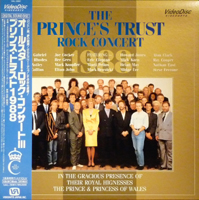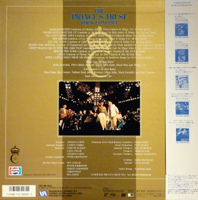- Intro
- Sledgehammer
- Never gonna give you up
- You can`t hurry love
- The letter
- You win again
- Money for nothing
- I don`t wanna go on with you like that
- Behind the mask
- Layla
- With a little help from my friends
including Obi


|
THE PRINCE'S TRUST ROCK CONCERT 1988 |
|
| Artist | Various artists (featuring Dire Straits) |
| Release date | 1988 |
| Recording | Royal Albert Hall, London, UK, 5th and 6th June 1988 |
| Format | 12 inch LaserDisc |
| Label | Videoarts |
| Cat.no. | VAL-3081 |
| Tracks side A |
|
|
Front & back cover
including Obi |


|
| Additional comments |
Recorded at the Prince's Trust Rock Gala 1988. Great show with Mark Knopfler playing on several tracks
other than Money for nothing. Great cover with a nice picture of all
musicians together with Princess Diana and Prince Charles. One
sided 12 inch LaserDisc, NTSC format, Japanese edition including seperate
info-sheet and Obi. |
| Extra information Obi |
An Obi strip is traditionally a strip of paper
looped around the left side or folded over the top of Japanese LP albums.
Obi strips are also found folded over the left side of music CD's, video
games, DVD's and even on the covers of books when they are sold new. The
Japanese word "Obi" refers to the traditional sash or belt worn with a
kimono. The features of the obi strip include the title of the product
usually in phonetic Japanese, the track listings, other information such as
price, catalog number and information on related releases or artists from
that same record company. |
| Laserdisc information | The LaserDisc (LD) is an obsolete home video disc format, and was the first commercial optical disc storage medium. Initially marketed as Discovision in 1978, the technology was licensed and sold as Reflective Optical Videodisc, Laser Videodisc, Laservision, Disco-Vision, DiscoVision, and MCA DiscoVision until Pioneer Electronics purchased the majority stake in the format and marketed LaserDisc in the mid to late 1980's. While LaserDisc produced a consistently higher quality image than its rivals, the VHS and Betamax systems, the laserdisc never obtained more than a niche market with videophiles in America. In Europe, it remained largely an obscure format. It was, however, much more popular in Japan and in the more affluent regions of South East Asia, such as Hong Kong and Singapore. Laserdisc was the prevalent rental video medium in Hong Kong during the 1990's. The technology and concepts provided with the Laserdisc would become the forerunner to Compact Discs and DVDs. |